#microbial balance
Explore tagged Tumblr posts
Text
Sustainable, Natural & Wellness-Promoting – KHEONI
Unveil Bliss with Kheoni: Sustainable luxury & wellness redefined—clean ingredients, responsible packaging, community-driven. Discover more Kheoni

#hairstyle#Ultimate wellness#Microbial balance#Health restoration#Inflammation regulation#Pathogen defense#Microbiome support#Wellness boost#Immune system fortification#Wellness Wonder#Gut Guardians#Microbial Magic#Health Heroes#Balance Boosters#Inflammation Fighters#Pathogen Protectors#Immune Allies#Gut Bliss
1 note
·
View note
Text
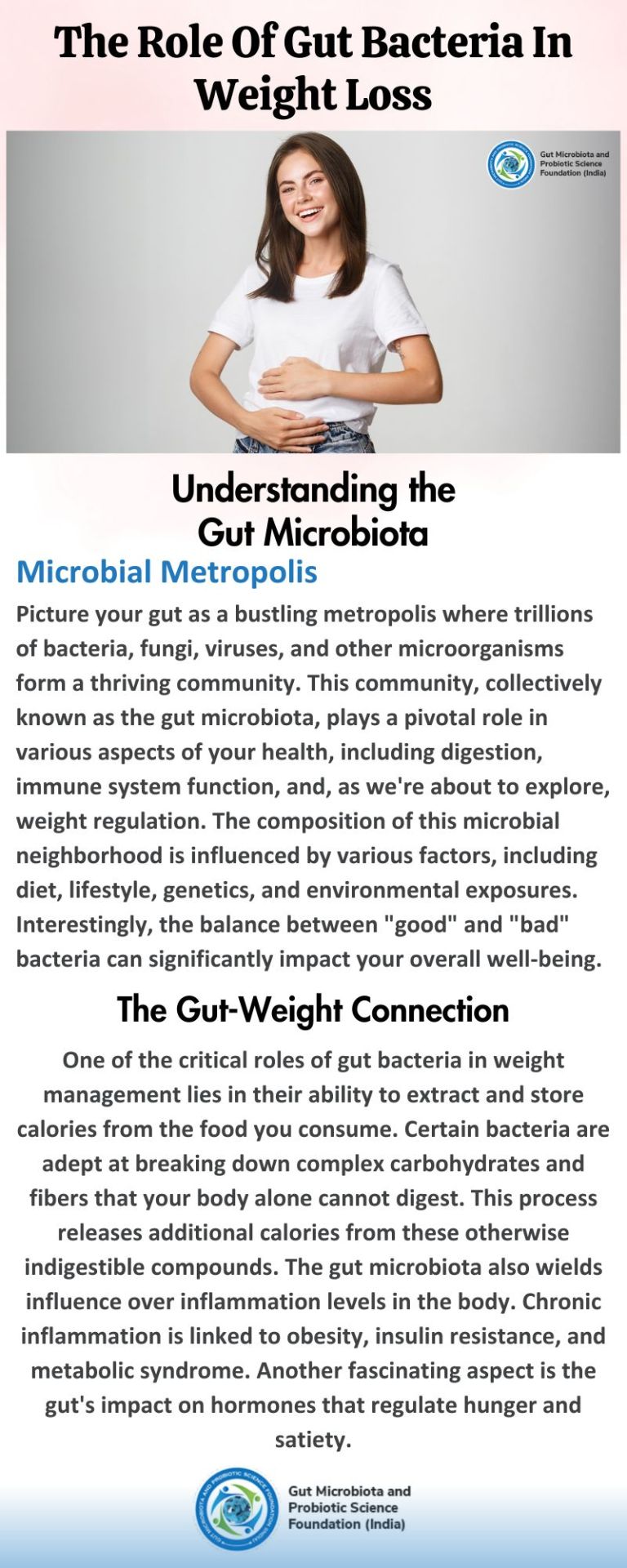
The Role Of Gut Bacteria In Weight Loss: All You Need to Know
Explore the intricate connection between gut bacteria and weight loss in our latest blog post. Delve into the fascinating world of the microbiome and discover how the trillions of microbes residing in your gut can influence your body weight. Uncover the latest research findings, practical tips, and insights into harnessing the power of a healthy gut for effective weight management.
#Gut bacteria#Microbiome#Weight loss#Gut health#Probiotics#Digestive system#Healthy lifestyle#Weight management#Metabolism#Microbial balance#gutfoundation
0 notes
Text
Unravelling the Wonders of Probiotics: A Journey to Better Health
Embrace Gut Health with the Mighty Power of Probiotics! In the realm of health and wellness, there’s a microscopic army working tirelessly to maintain our well-being – probiotics. These tiny beneficial bacteria have gained popularity as powerful allies in promoting a healthy gut and overall well-being. From boosting digestion to fortifying the immune system, probiotics play a significant role in…

View On WordPress
#beneficial bacteria#digestive health#gastrointestinal disorders#gut health#immune system#microbial balance#mood enhancement#oral health#probiotic supplements#probiotic-rich foods#probiotics#skin health#travel health#vaginal health#weight management
0 notes
Text
youtube
#Huangqin Decoction#colorectal cancer#gut microbiome#metabolic dysfunction#inflammation control#traditional Chinese medicine#microbiota balance#cancer prevention#colorectal inflammation#microbial diversity#cancer transformation#TCM therapy#holistic health#metabolic regulation#gut health#inflammatory cancer#cancer research#integrative medicine#chronic inflammation#precision medicine.#Youtube
0 notes
Text
ORGANIC ONION ESSENTIAL OIL
Pure Onion Essential Oil is high in Sulphur, a chemical that helps to thicken hair from the roots. It supports the natural pH of the scalp and encourages hair follicle development. All of this contributes to stronger hair. It is a natural anti-bacterial and anti-fungal substance that removes dandruff from the scalp. It inhibits microbial activity in the scalp and maintains the scalp's natural pH balance, resulting in nourished hair and a healthy scalp. Since onion oil has a high concentration of sulfur, it can naturally cure broken ends. Not only can onion hair oil encourage hair growth, but it may also be used to treat baldness. It provides a protective barrier on the skin and fights germs and contaminants in the environment.

#male baldness#essential oils#hair growth#PH balance#hair follicles#hair development#thicker hair#microbial activity
0 notes
Note
Hello baby borl can you write a spencer reid x reader where they are kind of awkward but they still are relatively outgoing but they never EVER make the first move so they just vaguely flirt with him but very awkwardly like... maybe they have an obscure favorite animal and they tell him about it and then they compare him to it and its funny bc its like.. a slug or a spider (an animal that many ppl dont like and dont find attractive)
Arachnophobia - S.R
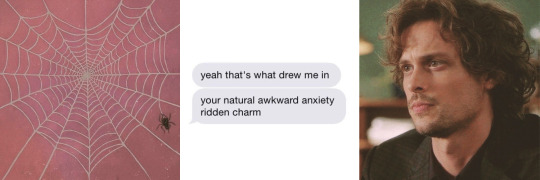
a/n: i dont know if baby borl was a misspelling or not but i am obsessed with it and i will now be referring to everyone as that from this point forward
ALSO thank you so much for the request i <3 an awkward reader truly
masterlist
‧₊˚ ✩°。⋆♡ ⋆˙⟡♡ ⋆˙⟡♡⋆。°✩˚₊‧
pairings: spencer reid x reader
warnings: spider! ah!, reader climbing on a chair like that's a little dramatic if you ask me, spencer being a little shit, fluffy fluff, cuties being awkward, comparing spencer to a female spider!
wc: 0.9k
"Oh my god!"
You didn't mean for your scream to be as loud as it was, it was more instinctive than anything, not having enough time to stifle it as you hopped upon the closest desk chair. Unfortunately for you, that chair happened to belong to the object of your affection—Spencer Reid, resident boy genius and pretty boy.
Pretty boy was the understatement of the century. He was the embodiment of aesthetic perfection in your eyes, a vision of loveliness that seemed almost otherworldly.
But that all receded to the edges of your brain, your gaze laser focused on the teeny tiny crawler scuttling across the carpeted floor beneath you.
"Is there a reason you're standing on my chair?"
Spencer's eyes were trained on your shoes, a frown forming as he undoubtedly considered the microbial invasion spreading from your soles to his well-maintained seat.
You couldn't say anything, mouth snapped shut as you just pointed to the hairy thing. He quirked an eyebrow, following your gesture before a soft chuckle escaped him, head shaking in the process.
You narrowed your eyes, not finding the same humor in the situation as he was. "Spencer, it's not funny. Get it please?"
"Well since you asked so nicely." He moved towards a box of tissues on his desk. But you grasped his wrist to stop him, your balance faltering, and a tiny squeal escaped you as you teetered on the edge of the chair.
His hold on your hip was immediate, the closest thing in order to stabilize you is how you rationalized it, saving you from an imminent face-to-floor meeting.
"Sorry," you said sheepishly, a low buzz spreading from your head to the spot where his hand enclosed around. "Don't kill it."
He gave you a pointed look, but then grabbed a plastic cup by the water cooler. You missed his hands on you the second he was gone.
He crouched down to where the spider was crawling around, carefully shoveling it into the cup.
"Don't hurt its legs!"
"I feel like there is a lot of protesting coming from someone who can't even put their feet on the ground right now."
That shut you up. A soft pout found its way to your lips as you folded your arms defensively. His smirk grew at the sight, and you couldn't stop the delightful warmth that bubbled up inside your chest, sticky and potent.
"Once the spider is at a safe distance then I'll come down," you said with a shrug.
He expertly secured the paper over the clear cup's mouth, trapping the spider inside. "All clear."
You watched his hands warily, your lips forming a tight line as you stayed put, eliciting an exasperated eye roll from him.
"It's not going to hurt you."
"You don't know that."
He angled the cup towards the light, inspecting the bug with a squint.
"It's unlikely you'll ever be bitten by a spider. They aren't interested in humans. They don't seek us out like mosquitoes or ticks do." He moved the cup in your direction. "This is just a common house spider, known scientifically as Parasteatoda tepidariorum. Completely harmless."
"It doesn't look completely harmless to me," you countered, wrinkling your nose and leaning back.
You almost lost your balance. Again. His hands found your waist. Again.
"How about you come down now?"
"Right, sorry I know you're probably freaking out about my outdoor shoes on your chair."
His hand moved to grab yours as you stepped down. "I'm more concerned about the potential of you cracking your skull."
You beamed, a wide smile lighting up your features as you planted your feet firmly on the carpet. "Eh, I'm pretty much indestructible."
"Tell that to the spider."
You tried to glare at him, but you were sure it came off softer around than edges than you intended, because you weren't really annoyed. Spencer's ease in teasing you was a recent development, it had taken ages to get to this point. The roles used to be reserved, but then you fell in love with him, and now every word you spoke had been nothing but overthought and stiff.
"He is a little cute actually." You stepped closer, gingerly at that, maintaining a safe distance just in case Spencer decided to pull any funny business.
"Well, he's a she."
"Oh, how impolite of me," you said, as you crouched down to bring yourself face-to-face with the spider.
"Interestingly, the female common house spiders are known for its problem-solving abilities when capturing prey. If the first attempt doesn't work, it will try different strategies, which shows a level of adaptability and intelligence."
"Awh, she's kind of like you, isn't she?"
You wanted to slap a hand over your face. You sounded like an idiot. His eyes narrowed, and then that charming little smile broke through, a little uneven, making him all the more appealing.
"That feels offensive."
You couldn't help but laugh, your eyes crinkling in response. "It's not, I swear, that was supposed to be a compliment."
"I'd be careful with those compliments, wouldn't want to inflate my ego too much."
Maybe tomorrow you'd tell him how you feel. Probably not.
taglist: @hotchhner @khxna
#spencer reid x reader#spencer reid fluff#spencer reid x awkward reader#spencer reid#spencer reid fic#criminal minds#criminal minds x reader#spencer reid x you
587 notes
·
View notes
Text
Waterfalls! These gorgeous, powerful features of nature have been oddly lacking in my past lists, I think in part because their danger has always seemed more “obvious” to me. But doing the research for this list has reawakened my phobia of the water. Some of the later entries (numbers 9 and 10 especially) brought back anxieties that I thought I had gotten over long ago, but it was kind of thrilling. Like watching a particularly scary horror movie. Let’s get into it!
1. Underwater Waterfall, Mauritius
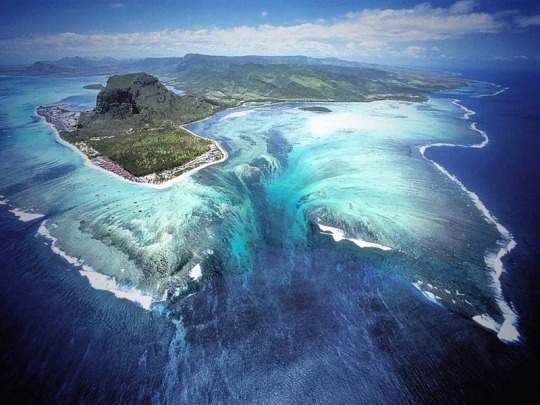
No, it’s not really a waterfall. It’s just an optical illusion caused by sand falling off the island’s slope down into the deeper water below. But it looks cool and scary, and the drop-off is 2.5 miles deep so that’s pretty impressive and I think it deserves at least a mention.
2. Blood Falls, Antarctica
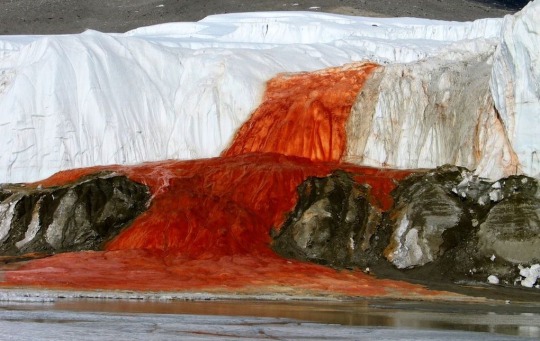
There’s nothing particularly dangerous about this one, it just looks incredibly creepy. Obviously, it’s not actually blood, it’s just water that’s very rich in iron. But the really fascinating part of this waterfall is that its source seems to be a subglacial lake that contains a unique microbial ecosystem which has been isolated for two million years! These microbes are like nothing else we’ve ever observed in nature before. They live in an incredibly cold and extremely saline lake, and metabolize sulfur and iron ions with no oxygen present. They are being used as a model to study what life on ice-covered alien planets could be like.
3. Khone Falls, Laos

This waterfall is not nearly as famous as some of the others on this list, which is surprising because it’s the widest waterfall in the world, with an average width of six miles! Although not particularly tall, it is the second most powerful waterfall in the world, more than double the power of Niagara Falls! The Khone falls divide the Upper and Lower Mekong river, making travel by boat between the north and south impossible. What makes it kind of unsettling to me is that during the rainy seasons the falls are basically swallowed up by the river, turning them from a spectacular waterfall to a series of massive rapids.
4. Huntington Gorge, Vermont
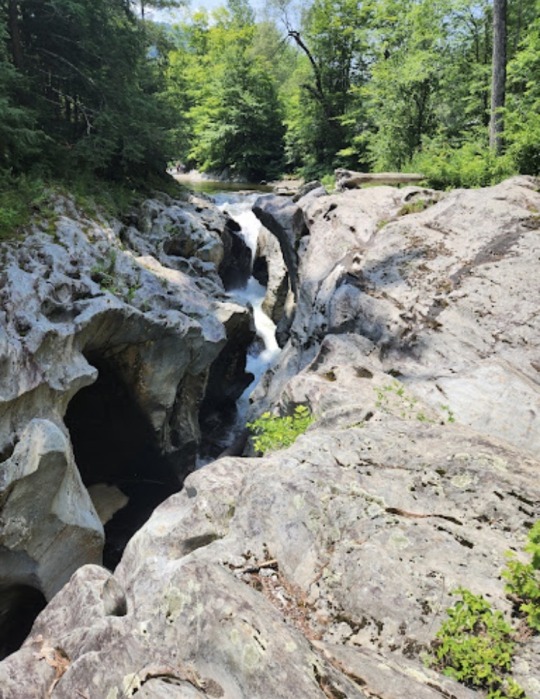
When water levels are low, this river is a popular and scenic swimming spot, and the canyon has an almost otherworldly quality with its unique bends and overhangs. Unfortunately, these very features are what makes it so dangerous. Much like the infamous Strid, the gorge is full of holes, steep drop-offs, and powerful currents hidden beneath the water, which can suck people in and trap them against the cliff walls. Over fifty people have died here since the 1950s, and many more have been injured. With proper precautions, one can safely explore the gorge and swim in the river, but don’t forget that this water has swallowed up many people before you.
5. Victoria Falls, Zambia
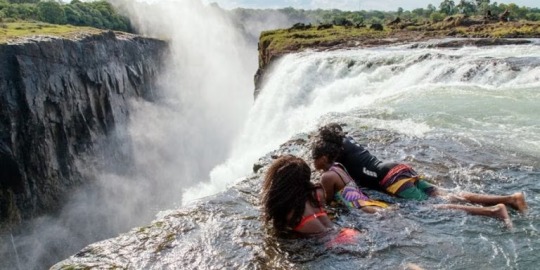
I’m sure most of you already know about Mosi-oa-Tunya, more widely called Victoria Falls, as the largest waterfall in the world. Formed as the Zambezi river pours into a series of massive gorges, this curtain of water spans nearly a mile and falls 300 feet with such force that columns of rising spray can be seen for miles around. Despite this, the pools around the lip of the falls can be relatively tame, and locals have fished while balancing on the edge of the cliff for generations. The safest and most famous of these fishing holes is the Devils Pool, which allows you to literally swim right up to the edge of the world’s biggest waterfall. The pool is actually very safe when the correct precautions are taken, and I can only find one death attributed to the pool specifically, when a tour guide in 2009 fell while trying to help a man who had slipped and was dangling off the edge (and, honestly, I was expecting a lot more deaths given the amount of clickbait articles advertising it as the most deadly swimming hole in the world). Although that was the only death from the Devils Pool, there have been many other deaths at Victoria Falls, mostly tourists who underestimate the power of the river or get too close to the edge. So if you ever visit this spectacular waterfall, please observe it from a safe distance and follow all the rules.
6. Huka Falls, New Zealand
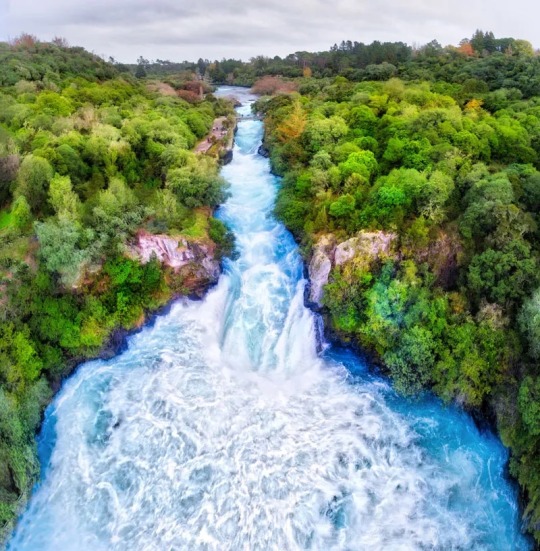
This is not a traditional waterfall, but rather a series of small waterfalls along a narrow stretch of the Waikato river, creating an incredibly turbulent chasm that ends in a whirlpool. The 300-foot wide river is funneled into a 50-foot wide stream, causing a torrent of water that flows at a rate of 58,000 gallons per second. Obviously, this is not an area that you should get in the water, but not everyone takes that advice. There have been multiple deaths at this waterfall, and a few narrow escapes, including two swimmers who, incredibly, survived after trying to raft down the falls on pool toys. Please, for the love of god, don’t do that.
7. Niagara Falls, US/Canada
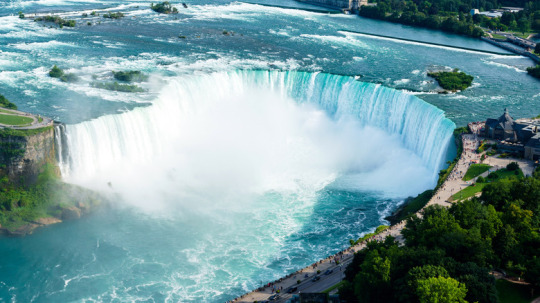
These falls are the only place on this list that I’ve visited, and I can tell you they are certainly an incredible sight, but also rather intimidating due to their sheer size and power. These three massive waterfalls are fed by the Great Lakes and, combined, have nearly 700,000 gallons of water thundering down every second. There is also a permanent whirlpool in the river that has existed for over 4,000 years and reaches depths of 125 feet! Besides being huge and awe-inspiring, these waterfalls are known for their appeal to daredevils who have gone over the edge in barrels or, in one case, a giant rubber ball. But these famous success stories are punctuated with tragedy. Roughly 20-30 people die at Niagara Falls every year. Most of these, sadly, are suicides, but others are failed attempts to replicate the successful daredevils of the past, and others are accidental. An estimated 5,000 bodies were recovered at the bottom of the falls between 1850 and 2011.
8. Murchison Falls, Uganda
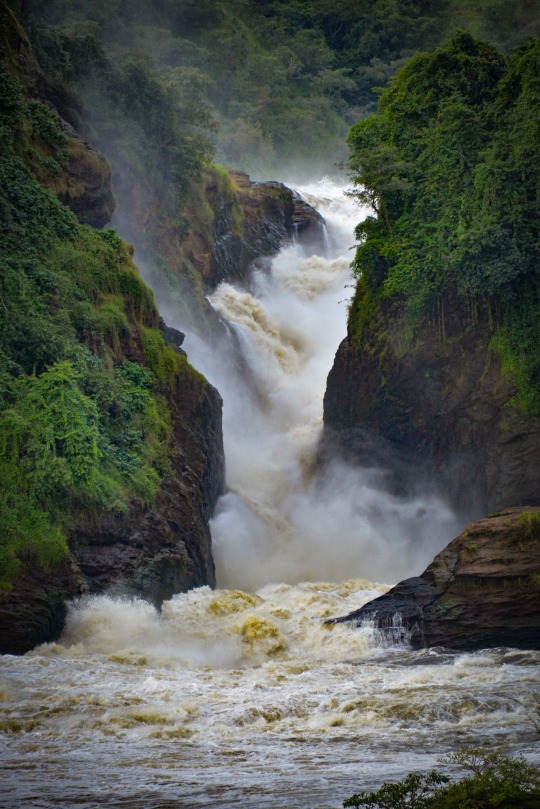
Also known as Kabalega Falls, this is the worlds most powerful waterfall. Formed as the Nile River flows from Lake Kyoga to Lake Albert, this waterfall is so strong it literally causes the ground to shake around it. Here, the Nile is constricted from a river nearly 400 ft wide to a passage only 20 ft wide, creating an incredibly turbulent and violent tunnel of water that tears its way into the pool below at 79,000 gallons per second. And this is no ordinary pool. Waiting below the falls is the highest concentration of large crocodiles observed anywhere in the world, waiting for any dead or stunned animals caught in the falls to wash into their lair. Although the waterfall and surrounding park are now a beautiful tourist attraction and wildlife refuge, the history of the falls includes tales of human and animal sacrifices, thrown in alive to appease the gods that some believed resided beneath the raging waters.
9. Bath Fountain, Jamaica
This is just a random little waterfall along a hiking trail, but the video triggered some intense bathophobia in me for the first time in a while. Like, I was scared to get in the shower after watching this. Proceed with caution:
youtube
10. Kipu Falls, Hawaii
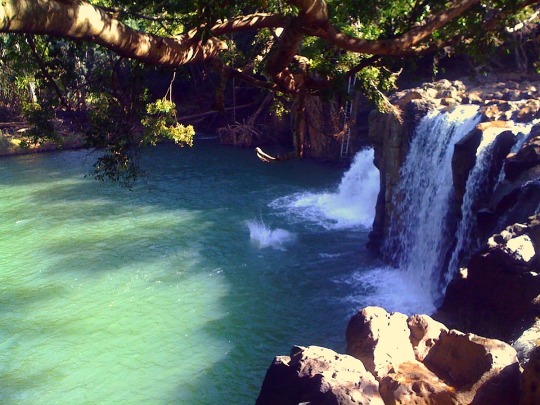
This one scares me because, despite my research, I can’t actually figure out what the hell is happening here. Multiple people have died here; all tourists, all drownings, all of seemingly very unclear causes. Kipu Falls is a beautiful and popular swimming spot, and locals frequently dive off the top of the falls with seemingly no danger. However, five deaths over the course of five years from 2006-2011 challenged its reputation of being a safe swimming hole. All the articles I could find seem to repeat the same information; there is no current in the pool and the waterfalls are not especially powerful. Despite these established facts, all five deaths were the same. Someone jumped in, surfaced, and then were dragged back down to the bottom of the pool and held there until they died. This has resulted in a lot of speculation, including everything from a hidden whirlpool current to evil spirits. I’m just. Really unsettled by the lack of information on this one. Every article I found was published in 2011 and I couldn’t find any updates, which hopefully means people aren’t still dying here, but… what the fuck???? Was going on????? Sorry guys this one might not be as dangerous as some of the others but it freaks me out a lot so it’s getting a higher rating. I want to know what’s going on but I’m sure not going to investigate it myself.
671 notes
·
View notes
Note
What is Sephiroth’s gut biome like? Has Hojo discovered any unique bacteria in his gut culture?
Like everything else about him, Sephiroth's gut biome is genetically enhanced to peak efficiency; fermentation, nutrient absorption, microbial balance, all flawless… until Angeal started feeding him. What was once a supplement-fueled gut suddenly looked alarmingly normal. Diverse flora. Improved digestion. Human-like bacterial colonies. Hojo lost it.
Hojo: Sephiroth, I've reviewed your lab results. There's been an anomalous spike in your gut microbiota. Why is your intestinal tract starting to resemble that of an average child?
Sephiroth: Angeal has been providing me with probiotic milk. It's those tiny plastic bottles that come with a smiling chocobo on it. They taste pleasant.
Hojo: Those are for children.
Sephiroth: So are the yogurt tubes with "Berry Blizzard" and "Moogle Mango" flavors. Angeal insists they aid my digestion.
Hojo: Your digestion was optimal. We've given you meticulously measured nutrient pastes and supplementation since infancy. Why would you pollute that system with bacteria-laden drinks?
Sephiroth: Angeal does not trust your "nutrient pastes." He's been preparing homemade foods. Kimchi. Kefir. Sourdough. Occasionally pickled radish. Last night he made bone broth with barley.
Hojo: None of those are in your nutritional plan. Your body belongs to Shinra. You cannot just consume foreign substances! I forbid this nonsense—
*Sephiroth calmly reaches into his coat pocket and pulls out a bag of colorful gummies shaped like materia*
Hojo: What is that??
Sephiroth: Stress snacks. Angeal said "if you're gonna listen to Hojo all day, you deserve a treat." They're fruit-flavored. Rich in collagen.
#ff7#ffvii#final fantasy 7#sephiroth#genesis rhapsodos#angeal hewley#final fantasy vii#crisis core#crisis core headcanons
53 notes
·
View notes
Note
also even if tarantulas WERE as intensive as keeping tropical fish, they'd still be an affordable pet.
I own a 190L tank and it costs maybe 10 bucks a month to run if I convert it to US dollars. Buy the additives in bulk, and established tanks don't need constant microbial balancing which tends to be the expensive bit.
Obvs I have to also factor in fish food on top of that but I keep only herbivorous or omnivorous species which happily eat algae wafers and slightly more meaty cory wafers, I have an established worm population in the detritus that supplements the omnivores food, etc. etc.
Fish themselves can be expensive but most small species live for at least 2-5 years, and big species can be up to 30 years, so if you're constantly having to restock, you're the problem.
My cat costs me 10x as much.
Also once you get the cleaning process down to a science it takes maybe 1-2 hours per week max. Not a big deal
I always love hearing about fish keeping. Love fish and their tanks, but the whole thing intimidates me and I'm terrible at it, so it's fun to live vicariously through you guys.
Tarantulas are so non-labor intensive it's almost perverse. They don't like to be handled and they don't like to be bothered, so we're talking "spot clean as needed, deep clean once every two years, maybe."
27 notes
·
View notes
Text
New study finds invasive plants drive homogenization of soil microbial communities across U.S.
https://news.rice.edu/news/2024/new-study-finds-invasive-plants-drive-homogenization-soil-microbial-communities-across-us
The research . . . shows that invasive plants with fast-growing root systems outcompete native species and disrupt the natural balance of soil microbes. This process known as biotic homogenization leads to less diverse ecosystems as ecological communities become more similar over time. The study highlights a critical yet often overlooked aspect of plant invasions: their profound belowground effects on soil health and biodiversity
Hopefully this will lead to more research in restoring microbialcommunities to better support native plants, especially those that are more challenging to establish, and speed up restoration efforts in order to create ecosystems that are more resistant to disruption
#I was just wondering about this a few months ago#given the challenges of reestablishing native plants in places completely overgrown by invasives#and seeing the differences in the soil myself#ecology#native plants#invasive plants
13 notes
·
View notes
Text


Insects, just as on Earth, have become tremendously successful on HP-02017: overshadowed by the hamsters and their spectacular descendants, but nonetheless unimaginably numerous, diverse, and vital to the balance of the countless ecosystems and biomes that have flourished across the planet for millions of years, from cold polar tundras to temperate forests to scorching deserts and, in the Middle Temperocene, a time of flooded coasts and expanding oceans thriving with life in its sunlit shallows, even the seas itself.
Many dipteran flies and a few hymenopterans too have taken up partial residence in coastal areas, convergent with Earthly brine flies, whose larvae live in shallow, salty tide pools and whose adults gather in massive swarms by the beach, where they in turn feed a wide array of wildlife such as ratbats, pterodents, rattiles, shrabs, squoads and more. But few live out in the open ocean, a realm whose arthropod inhabitants are instead governed by the shrish, their numerous basal krill ancestors and loads upon loads of nondescript zooplanktonic crustaceans. Yet the presence of coast kudzu, an unconventional, fast-spreading sea grass that floats entirely on the surface and can blanket whole square kilometers of ocean surface in favorable regions, provides a suitable habitat for the most unlikely of marine insects: the kudzu seatle (Thalassoscarabus spp.)
Descended from freshwater diving beetles that likely in turn descended from the darkling beetle Tenebrio molitor, one of the planet's earliest colonists, the kudzu seatle's ancestor was among the many victims of coastal storms that were swept out to sea and became unwitting pioneers. While many unfortunately perished and a lucky few made it to oceanic islands where they flourished, others, of more salt-tolerant strains, remained out at sea, some making it to the patches of coast kudzu where their descendants have flourished ever since.
Kudzu seatles spend much of their time clinging among the tangled floating forests of leaves and stems, to rest, hide themselves from predators, and to lay their eggs. Their eggs, laid in clusters of up to a hundred at a time, are attached to the stems of coast kudzu, where they hatch within a few days' time into small, bristly larvae that cling to the coast kudzu with their six thoracic legs to feed on microbial aggregations, algae, plankton and organic detritus, but are capable of swimming actively through jerky wiggling motions of their abdomens. When at rest, the larvae cling near the surface and extend an abdominal breathing tube to the surface, in order to breathe air, quickly diving and holding their breaths when disturbed by waves and ascending once more as the surface calms. As the larvae grow, they become ever more voracious, soon after graduating to feeding on the coast kudzu itself in its later instars. Once it reaches a full size of roughly two inches, it stops feeding and prepares itself for its transformation.
Yet in the open sea, there are few, if any, places for a larva to safely hole up in and become immobile for a prolonged period of time. As such, the kudzu seatle has an unconventional adaptation: a motile pupa, capable of swimming actively through contractions of its abdomen and possesses a specialized reserve of fat to fuel its motility, separate from its energy sources that guide its transformation as it does not eat for the two-week duration of its pupation. It now breathes at the surface through two thoracic tubes, and spends much of its time at the surface, diving back down when disturbed by vibrations and shadows.
At last, after an average of 14-16 days, the adult finally ecloses as a mature beetle, clinging to the surface of the coast kudzu to allow its elytra to harden. The pupae, guided by hormonal and light triggers, all emerge simultaneously just after sunset where they are much safer from predators. By dawn their exoskeletons will have hardened, their elytra now serving as oxygen tanks where they store bubbles of air, and now, swimming along with the aid of bristly legs and possessing excretory organs derived from their gut lining that clear their bodies of excess salt, the adults begin the final phase of their life cycle, being active hunters of zooplankton and larval shrish and pescopods, as well as feeding on the sap of coast kudzu as a supplement of energy-rich carbohydrates, throughout their adult life that can last as long as six months to a year depending on the species and local climate, throughout which they constantly mate and reproduce incessantly, with each female able to produce as many as 600-1000 eggs in a lifetime.
Various species of kudzu seatle are found across the oceans of HP-02017, such as the most common coastal kudzu seatle (Thalassoscarabus larsoni), which is predominantly a omnivorous plankton-feeding denizen of shallow tropical seas, to the larger pelagic kudzu seatle (T. shocirus) that is a more active hunter of smaller invertebrates in coast kudzu patches in open waters far from shore, to the forest kudzu seatle (T. puget) that thrives in the "emergent layer" of seagrass forests and experience massive population booms each summer that become a feast for predators of all kinds. The latter species, ranging around the shores of South Ecatoria, are very familiar to shore-dwelling calliducyons such as the baywulves and riveners as their breeding explosions seasonally blanket the surface with millions of larvae, many of which wash ashore and are considered a seasonal treat by the ocean-side foragers: though "sea bug season" does not last, as, while the larvae and particularly the fat-rich pupae are a favorite of theirs, the hard-shelled adults they eventually metamorphose into are considered bitter, chewy and highly unpalatable. Due to the somewhat shrimplike appearance of the larva and pupa, the calliducyons do not distinguish them from shrish and merely consider them as just another species of shrish, or "seaswimmer bug": though the resemblance of the adult to terrestrial beetles has not gone unnoticed by the riveners who call it in their dialect as "sea land bug", the paradoxical statement of which is the subject of local rhymes, songs and amusing folk stories.
----------
#speculative evolution#speculative biology#spec evo#speculative zoology#hamster's paradise#ask#spectember#species profile
79 notes
·
View notes
Text
The Role Of Gut Bacteria In Weight Loss: All You Need to Know
Explore the intricate connection between gut bacteria and weight loss in our latest blog post. Delve into the fascinating world of the microbiome and discover how the trillions of microbes residing in your gut can influence your body weight. Uncover the latest research findings, practical tips, and insights into harnessing the power of a healthy gut for effective weight management.
#Gut bacteria#Microbiome#Weight loss#Gut health#Probiotics#Digestive system#Healthy lifestyle#Weight management#Metabolism#Microbial balance#gutfoundation
0 notes
Text
The Human Microbiome: Your Body's Little Ecosystem
Within each of us exists a fantastic and complex microscopic universe known as the human microbiome. This ecosystem of microorganisms that inhabits our body plays a fundamental role in health and homeostasis. Today, we will fully explore this fascinating microbial world and its influence on our physiology.
What is the Human Microbiome?
The human microbiome is a profoundly intricate biological system integral to our health and well-being. This term, "the human microbiome," encompasses a diverse consortium of microorganisms that have firmly established themselves within and upon our bodies. This assemblage comprises a wide array of microorganisms, encompassing bacteria, viruses, fungi, and various other microbes, each with their specialized ecological niches within our anatomy.
Upon a deeper examination of the human microbiome, we uncover a meticulously organized distribution of these microorganisms. They do not merely coexist haphazardly within us; instead, they strategically colonize specific regions of our body. For instance, they form robust communities within the gastrointestinal tract, resulting in the gut harboring a densely populated microcosm. Similarly, they stake their claim on our skin, and even the respiratory tract serves as a habitat for these microbial entities.
The human microbiome's remarkable aspect lies in the intricate and dynamic interactions it maintains with our own organism. These microorganisms are not passive bystanders; they are active participants in the intricate orchestra of physiological processes. They exert influence over our digestion, bolster our immune system, and wield the potential to affect our mental and cognitive faculties. This complex web of symbiotic relationships between our human cells and these microorganisms constitutes an ever-evolving interplay that exerts a profound impact on our overall health.
The human microbiome is not a mere collection of microbes; it is an entire ecosystem nestled within us, a thriving and dynamic world with the potential to significantly modulate our health. Comprehending the intricacies and subtleties of this microscopic community represents an ongoing and critical pursuit in the realms of scientific and medical research, with profound implications for the fields of medicine and biology.
Solid Scientific Evidence
To support the importance of the human microbiome, here are three relevant scientific references:
Title: "The Human Microbiome: A Key Contributor to Health." Autores: Sender, R., Fuchs, S., & Milo, R. Revista: Journal of the American College of Nutrition, 2016. Abstract: This article reviews the role of the human microbiome in health and disease, highlighting its influence on digestion, immunity, and nutrient synthesis. It also emphasizes its contribution to metabolic and autoimmune diseases.
Títle: "The Human Microbiome: Gut Microbiota and Health." Autores: Marchesi, J. R., Adams, D. H., Fava, F., Hermes, G. D., Hirschfield, G. M., Hold, G., ... & Rook, G. A. Revista: The Journal of Infection, 2016. Abstract: This study focuses on the intestinal microbiota and its relationship with human health. Explore how alterations in the microbiome can contribute to gastrointestinal, inflammatory, and metabolic disorders.
Títle"The Skin Microbiome: Impact of Modern Environments on Skin Ecology, Barrier Integrity, and Systemic Immune Programming." Autores: Kong, H. H., Andersson, B., & Clavel, T. Revista: World Allergy Organization Journal, 2016. Summary: This article examines the skin microbiome's influence on skin health and immune response. It highlights how modern environmental factors can upset the microbial balance and affect the skin's health.
Future perspectives
Studying the human microbiome is a constantly evolving field that promises new therapeutic strategies and a deeper understanding of human health. As we continue to investigate this small ecosystem, doors are opening to personalized interventions to promote health and prevent disease.
Would you like to learn more about this fascinating subject? Share your thoughts and questions in the comments!

#science#biology#college#education#school#student#medicine#doctors#health#healthcare#nursing#nurses#higher education#microbiome#molecular biology
79 notes
·
View notes
Text
skincare cheat sheet
✨acne prone skin✨
look for ingredients such as benzoyl peroxide, sulfur, retinoids. benzoyl peroxide & sulfur both have anti-bacterial properties that can help kill the bacteria as well as being anti-microbial which can help reduce the growth of bacteria and soothe the skin. my skin personally likes sulfur whenever i have a breakout.
*minimize your skin routine* this is super important because if you are prone to acne you may or may not know what is causing your breakouts!! it could be a product in your routine that is clogging your pores, it could be hormonal, it could even be that your skin barrier is so dry and it's prompting your body to over create more oil which is causing you to breakout more often. i recommend plugging in all of your current products into the skin safe website and checking out if any are comedogenic. try resetting your routine and start out with a non-comedogenic face wash, moisturizer & spf. stick with that for atleast 2-4 weeks and then start slowly introducing other things that will contribute to reaching your skin goals.
pimple patches <3 (not the star face ones) i'm a huge lover of pimple patches, i love using them because not only do they distract me from picking my blemishes but they also help in aiding my blemishes as well. i recommend panoxyl patches because they actually work. they don't slide off, they stay on even after i've applied my products and they are more affordable than others. i've tried the starface ones and while they are cute.. they're ineffective. they do not suck up anything and half the time they will fall off your face even without product. and they're expensive. if you do enjoy the star shaped patches but want some that are actually effective i recommend amazon! i purchases pink stars that work just as well as my panoxyl ones and are just as affordable!
hydrate & moisturize!!! drink your water and moisturize your face, this is said all the time but it truly does make a difference.
pay attention to your diet. what you may be putting into your body may be a sign of what it showing on the outside. fried foods, dairy, carbs, and sugar can all contribute to acne. i'm not saying you can't have these ever again but they should be enjoyed within in reason. it's all about *balance*
visit a derm. if you have the luxury of visiting a derm, please do so. a derm can help you figure out the root cause of what's causing your acne along with guiding you on what to do next.
source: a girl who has been boderline hot her whole life that suffered from acne growing up
#borderlinehot#looksmaxxing#self care#self improvement#trophywife#skincare#girlblog ♡#girl blogger#this is a girlblog#dream girl#it girl#becoming that girl#pink pilates princess#affirmations#aesthetic#dreamgirl#self healing#hyper feminine#clean girl#glow up journey
94 notes
·
View notes
Note
Is there anything from your WIP that you want to talk about/give a more detailed explanation of but haven't had an opportunity to?
Probably the whole "in the beginning" sequence if I'm being honest. The base worldbuilding. So let's do it!
Before there was anything, there was nothing. There was darkness, silence, and the endless void. It couldn't have been called happy, this void, but perhaps it was content.
Then, a spark came into the universe. Now, we had something. There was light, sound, and chaos. There were stars and young planets and baby galaxies just beginning to glow.
In eons hence, these two forces would be called many names, but for simplicity's sake, we can call them End and Beginning. Each was a collection of minds, a colonial organism on a massive scale. For a while, there was balance between the two. The minds of Beginning resided in the stars and churned out planets, some of which harbored early, microbial life. The minds of End resided in the dark inbetween, and made sure Beginning didn't overstep its bounds. However, in time, End grew bitter. It didn't like this bright, noisy, chaotic universe. It wanted things to go back to how they were before.
And so it began to exterminate Beginning.
Stars bled out and died as the universe was plunged into war. Beginning tried to fight back, but it was a creative force, not a destructive one, and it was no match for End's gluttonous march. Billions upon billions of galaxies were destroyed, consumed by the nothing that was there first, until finally, there was only one lonely mind of Beginning left.
We can call this mind the Creator. While its brethren were being devoured, this single mind in its yellow star set to work creating sentient life. It split off two aspects of itself to do this; one to create the body, the other to forge the soul. The Illarians call these aspects Tsa and Ayu. The dwarves call them the Prime Twins. But either way, humans and dwarves were not the first people they created. First came the Araunians.
As End closed in above, chewing through the nearby stars and the more distant planets in the solar wheel, the Araunians split and morphed into the varied peoples that crowd Illaros today. Humans and goblins, sirens and selkies, and only one race of elves so far. All of these disparate people had one thing in common though; they had gods.
Through the power of their souls, divine sparks given to them by the Creator itself, the gods these peoples imagined sprang into reality. The Illarian, the Aderenon, the Nabafyrian ancestors, the Great Anglerfish, and many more. These were the children of mortality, grandchildren to the last mind of Beginning left living. This mind, the Creator, had only one message for the powerful new gods: "Get out there and fight that fucking thing!!"
The gods are not bound by the rules of creation and destruction, but instead can levy both equally. They rushed to fight End, to push it back from where it had besieged them and their makers, and they have been fighting for every moment since then. Through their efforts, the mortals of Illaros have been able to grow, develop, and evolve. The Creator has survived as the last of its kind. And though the universe is so terribly empty, it will never be nothing again, so long as the gods of Illaros defend all of something.
Without any true stars besides the sun though, what do the people of Illaros see in the night sky, you might ask? Well, they see what they think are stars---bright, white, untwinkling lights. In truth, these are the eyes of End, everwatching and everwaiting to devour the last bastion of life in all of the universe.
Thanks for the ask! I figured I'd brought End up enough that yall were owed a bit of an explanation. Hope this is interesting!
(As another side note: the words Illaros (the planet everyone lives on) and Illarian (the human gods) are so similar because they're both human words that stem from the same root. 'Illa' means horizon in Janazi (human language) and is an important concept to the seafaring people. A person from Illaros would be called Illari, though no such word exists on Illaros today, because they don't know about other planets yet, so why would they specify)
(Again, thanks for listening to me rant about worldbuilding)
(Have a bitchin day <3)
(Whoops here's my tag list @amandacanwrite @elsie-writes @riveriafalll @kosmic-kore @kaylinalexanderbooks @bard-coded @carrotsinnovember @patternwelded-quill @somethingclevermahogony @whatwewrotepodcast @goldxdarkness @the-angriest-author @mk-writes-stuff)
17 notes
·
View notes
Text
Excerpt:
The researchers argue that even before humans arose, Earth’s biosphere—the global system of all life on the planet—may have displayed some of the hallmarks of planetary intelligence in a nascent form. Ancient microbial life caused profound changes in Earth’s atmosphere, like the Great Oxygenation Event 2.4 billion years ago. These changes then fed back on life, enabling new forms of oxygen-using biology and more complex ecosystems. In this way, the researchers argue the ancient biosphere “recognized” planetary states like global chemical balances and collectively responded in ways that altered those states, making the planet more stable and favorable for life in the long run. This could be seen as a very simple form of global information processing and adaptive behavior.
17 notes
·
View notes